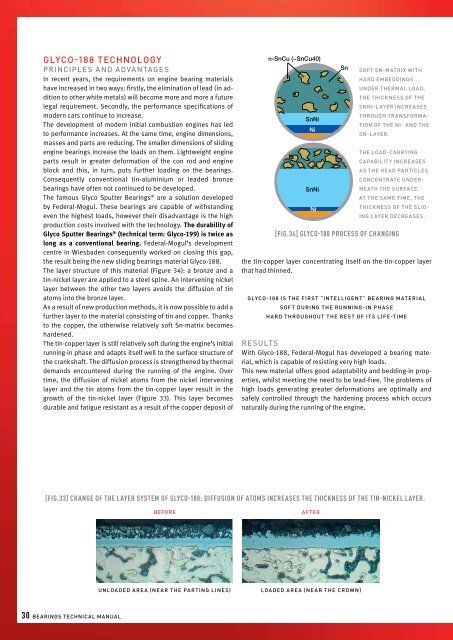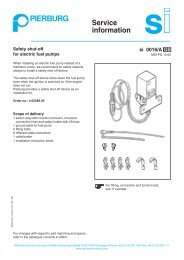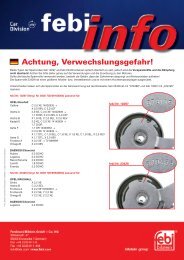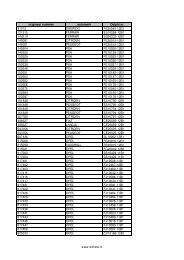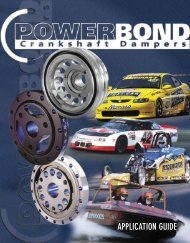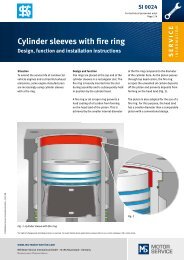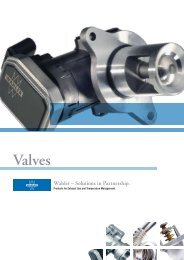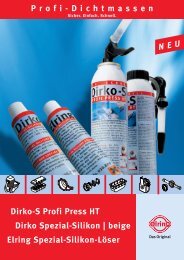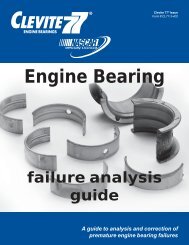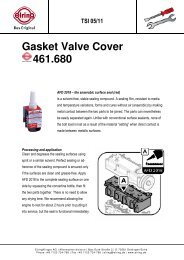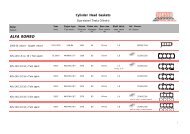EvEry bEaring you nEEd
EvEry bEaring you nEEd
EvEry bEaring you nEEd
Create successful ePaper yourself
Turn your PDF publications into a flip-book with our unique Google optimized e-Paper software.
GLYCO-188 technology<br />
Principles and advantages<br />
In recent years, the requirements on engine bearing materials<br />
have increased in two ways: firstly, the elimination of lead (in addition<br />
to other white metals) will become more and more a future<br />
legal requirement. Secondly, the performance specifications of<br />
modern cars continue to increase.<br />
The development of modern initial combustion engines has led<br />
to performance increases. At the same time, engine dimensions,<br />
masses and parts are reducing. The smaller dimensions of sliding<br />
engine bearings increase the loads on them. Lightweight engine<br />
parts result in greater deformation of the con rod and engine<br />
block and this, in turn, puts further loading on the bearings.<br />
Consequently conventional tin-aluminium or leaded bronze<br />
bearings have often not continued to be developed.<br />
The famous Glyco Sputter Bearings ® are a solution developed<br />
by Federal-Mogul. These bearings are capable of withstanding<br />
even the highest loads, however their disadvantage is the high<br />
production costs involved with the technology. The durability of<br />
Glyco Sputter Bearings ® (technical term: Glyco-199) is twice as<br />
long as a conventional bearing. Federal-Mogul’s development<br />
centre in Wiesbaden consequently worked on closing this gap,<br />
the result being the new sliding bearings material Glyco-188.<br />
The layer structure of this material (Figure 34): a bronze and a<br />
tin-nickel layer are applied to a steel spine. An intervening nickel<br />
layer between the other two layers avoids the diffusion of tin<br />
atoms into the bronze layer.<br />
As a result of new production methods, it is now possible to add a<br />
further layer to the material consisting of tin and copper. Thanks<br />
to the copper, the otherwise relatively soft Sn-matrix becomes<br />
hardened.<br />
The tin-copper layer is still relatively soft during the engine’s initial<br />
running-in phase and adapts itself well to the surface structure of<br />
the crankshaft. The diffusion process is strengthened by thermal<br />
demands encountered during the running of the engine. Over<br />
time, the diffusion of nickel atoms from the nickel intervening<br />
layer and the tin atoms from the tin-copper layer result in the<br />
growth of the tin-nickel layer (Figure 33). This layer becomes<br />
durable and fatigue resistant as a result of the copper deposit of<br />
T+P<br />
π-SnCu (~SnCu40)<br />
SnNi<br />
Ni<br />
SnNi<br />
Ni<br />
the tin-copper layer concentrating itself on the tin-copper layer<br />
that had thinned.<br />
Glyco-188 is the first “intelligent” bearing material<br />
Soft during the running-in phase<br />
Hard throughout the rest of its life-time<br />
Results<br />
With Glyco-188, Federal-Mogul has developed a bearing material,<br />
which is capable of resisting very high loads.<br />
This new material offers good adaptability and bedding-in properties,<br />
whilst meeting the need to be lead-free. The problems of<br />
high loads generating greater deformations are optimally and<br />
safely controlled through the hardening process which occurs<br />
naturally during the running of the engine.<br />
Sn<br />
Soft Sn-matrix with<br />
hard embeddings.<br />
Under thermal load,<br />
the thickness of the<br />
SnNi-layer increases<br />
through transformation<br />
of the Ni- and the<br />
Sn-layer.<br />
The load-carrying<br />
capability increases<br />
as the head particles<br />
concentrate underneath<br />
the surface.<br />
At the same time, the<br />
thickness of the sliding<br />
layer decreases.<br />
[fig.34] Glyco-188 process of changing<br />
Conclusion<br />
Engine bearings operate in a brutal environment. With a broad range of engine<br />
operating speeds, temperatures and other parameters, these vital components<br />
are called on to protect the crankshaft and engine block from premature wear and<br />
catastrophic damage.<br />
To wear is, in fact, what bearings are expected to do, very gradually, over millions of<br />
engine revolutions and thousands of miles. But protecting the bearings themselves from<br />
accelerated wear is the job of the engine rebuilder, who must ensure that the engine is<br />
free of dirt and debris and that all appropriate internal tolerances are maintained.<br />
Dirt is the engine bearing’s most common enemy. In fact, most premature bearing<br />
wear can be traced to dirt particles in the lubricating oil. That’s why the removal<br />
of contamination throughout the engine repair process is critical.<br />
A quality rebuilding job also requires strict attention to internal operating tolerances.<br />
Dimensional and shape variances in the crankshaft journals, mating surfaces<br />
and housing bores can cause immediate and severe damage to a rebuilt engine.<br />
To ensure the quality of any rebuild, the technician also should carefully document<br />
in writing each step of the repair. If a subsequent question or reliability issue arises,<br />
this record of the repair process can serve as an invaluable guide in identifying and<br />
eliminating any problem.<br />
[fig.33] Change of the layer system of Glyco-188: Diffusion of atoms increases the thickness of the tin-nickel layer.<br />
BEFORE<br />
AFTER<br />
Unloaded area (near the parting lines)<br />
Loaded area (near the crown)<br />
Important: Claims for damages, of any form whatsoever, resulting from details made in this brochure or from incorrect use, application, storage or handling, are explicitly excluded. This brochure is not an<br />
operating manual for the use and installation of the bearings. It does not contain any advice in a legal sense. The brochure neither replaces the constantly applicable technical regulations – particularly for<br />
tolerances – nor the installation and maintenance stipulations of the individual engine manufacturer. Also, it is not possible to forego the expertise of those carrying out the installation and application.<br />
The individual references made in this brochure for the installation and the application of the bearings are instructions solely for the technically qualified specialists and are to be checked and verified by<br />
him for their suitability in each case. Federal-Mogul/GLYCO accepts no responsibility for application decisions.<br />
Reproduction of this brochure of parts hereof is only allowed with our explicit permission in writing. Pictorial representations and design are copyrighted. The right is retained to correct errors and alterations.<br />
30 Bearings Technical Manual<br />
31


